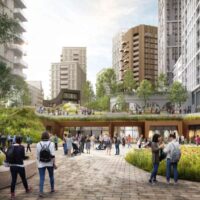Sustainable places: Q&A with Doug Higgins at First Base
Doug is Project Director at First Base, where he is in charge of a number of large-scale development projects. He joined First Base in 2018 after 8 years working at London & Aberdeen Group, where he headed up a number of major mixed-use projects. He began his career working for DTZ where he qualified as a chartered surveyor.
How did you get into sustainability?
Having studied Natural Sciences at Durham University, majoring in geology and physics, this gave me a good understanding of the Earth’s climate and its natural cycles looking back at data over millions of years. Having this background helped me put into context the frightening changes that we’re seeing now, where human activities are leading to unprecedented rates of change in global temperatures. The course also gave me an understanding of exciting, new sources of energy, such as fusion, which has the potential to provide a clean, almost infinite power supply if it can be cracked. And of course the ‘Attenborough effect’ has had a huge impact.
How did you begin at First Base, and what is your role?
Well, the Natural Sciences route was potentially leading me towards the oil industry, but having done some work experience in the industry and understanding its impact on the environment, I ruled it out as a career. I qualified as a chartered surveyor at DTZ (now Cushmans) and then gained experience in property development working with my father before joining First Base. I’m a Project Director, along with three others, and we all have complete responsibility for our assigned projects which we take forward from site acquisition and business plan development, through planning all the way to delivery and the end sales and lettings.

Tell me about the Devonshire Gardens Cambridge project we are working with you on
Yes – that's a hugely exciting one. It’s in Cambridge City centre, a 5-minute walk from the train station, so it’s a very sustainable, brownfield location. It’s a 3-acre site so it has that critical mass with the potential to deliver a genuine mixed-use neighbourhood and new community. It’s especially motivating with everything that the city and county councils are talking about in terms of sustainable transport. They’ve also both declared a climate emergency so we’re seeing how we can contribute towards their response.
The vision is going to be much like the Soapworks project in Bristol, which Bioregional has also worked with us on – it’s going to be car-free as far as possible, except for Blue Badge spaces for example. The idea is to have exemplary bicycle facilities. One problem with many buildings is that when you arrive on your bike you're usually forced to use an industrial-looking backdoor, and forbidden from using the main, front entrance. We want the cyclists’ experience to be exceptional and prioritised every bit as much as pedestrians.
Another thing I’m passionate about is sustainable timber, used structurally within buildings. Right now it’s still challenging in terms of residential building regulations, but I’d love to see how we can deliver a mass timber office building or two within the site. For instance, we’re looking at cross-laminated timber (CLT) slabs. They ’lock-in’ a huge amount of carbon, as well as benefitting the wellbeing of occupiers when it is left exposed on the ceiling, for example.
And you’re using the One Planet Living framework on your Devonshire Gardens project?
Yes, we're working with Bioregional on three projects now – this one, Soapworks in Bristol, and MK Gateway in Milton Keynes, and we’re using the One Planet Living framework for all of them. The team at Bioregional really know how to challenge us to ensure we enhance environmental performance as much as possible.
Every company should be obligated to report on their impact on the environment and society

What attracted you to the One Planet Living framework?
I really admired how the One Planet Living framework communicates the various credentials of a project, and also demonstrates how they're interlinked; from sustainability to social value, health and wellbeing. And it has very robust scientific principles behind it. Sometimes the science can get lost in translation and people switch off, but One Planet Living is very user-friendly.
For developers in particular, what do you see as the main opportunities and challenges of getting to One Planet Living and achieving net-zero carbon?
I think there’s sometimes a misunderstanding around net-zero carbon. When most people talk about it, they tend to focus on the operational carbon footprint of a building or a project. This is hugely important - but that is already coming down as a result of better insulation and the decarbonisation of the grid with the increase of renewable energy sources. So for me, one of the biggest opportunities is with embodied (upfront) carbon – in other words, reducing the amount of carbon emissions generated as a result of the construction process - and reducing the amount of concrete in particular, as it’s one of the worst carbon emitters in the industry.
As I mentioned earlier, the opportunity I'm really excited about is the use of timber as a replacement for concrete. It’s a huge challenge at the moment, even with commercial buildings – particularly from an insurance and financing perspective. But what is increasingly looking attractive and deliverable are hybrid structures, where you have a combination of a steel superstructure with CLT slabs. And if the steel is fabricated in an electric arc furnace, then it actually has a reasonably low carbon footprint, which can be completely offset by the CLT slabs.
What do you think is the biggest barrier to creating a built environment that has low embodied carbon and low operational carbon emissions?
I think the biggest challenges to rolling out mass timber buildings is the current building regulations and the insurance market. There's a perception that timber is a highly combustible product. But if you’re looking at timber for structural beams and columns, it actually stands up very well in a fire, and better than steel in a lot of cases. So there’s a job to dispel common misconceptions on that.
Water damage is also a key issue, and it's down to developers like us to work closely with insurers at an early stage to get them comfortable with the risks. Water damage is every bit as much of a risk than fire – whether it is leaks from water pipes, encapsulated moisture during construction or water leaking in from outside. If that’s not detected, then, of course, it can lead to rotting timber and deterioration, which is potentially very expensive to fix. It’s up to us to come up with solutions to deal with those risks to get insurers comfortable.
What would you say is the business case for sustainability for First Base?
The measurement of risk, which started some 70 years ago, completely transformed the way people invested and gave rise to new asset classes and Modern Portfolio Theory. That same revolution is now being brought about by environmental value and social value, which in many ways are actually a lot easier to measure and quantify than risk.
As companies, quite rightly, are increasingly obligated to report on their impact on the planet and society, investors will be embarrassed by investing in companies that don’t mitigate against their negative impacts. Increasingly, there will be a focus on companies that not only want to do well but also do good at the same time, and I think those will be the investors and the companies that will prosper.
How optimistic do you feel about that happening quickly enough?
I’m confident it's coming - everything's moving in that direction, but it can never happen quickly enough. Every company should be obligated to report on their impact on the environment and society.
We can see some excellent examples of measuring, reporting and delivering a positive impact for people and planet, whilst also delivering profit – from BrewDog to Toms. There’s a real movement and interestingly it’s become the focus of a book published this year by social impact pioneer, Sir Ronald Cohen.
We're starting to see change, but there are many companies that are resisting, and turning a blind eye to their negative impacts as long as they are continuing to reap the financial rewards. However, I don’t believe this can be sustained.
We believe our industry is enhanced by celebrating diversity and will continue to work towards a more inclusive society, especially as we look to build back better

Social value is very important to First Base. How do you think this year’s renewed focus on the Black Lives Matter movement has impacted how you look at social value and diversity?
Diversity is something we’ve always had a focus on, and for us that starts at the project consultation stage. We like to engage with the local community and stakeholders at the earliest possible opportunity. We're now embracing a new digital consultation platform, using social media for highly geo-targeted polls.
This is really making a difference - we used to get a few hundred responses to our ‘analogue’ consultation forms, which attracted a vocal minority from a very narrow demographic. But with the digital platform we now get thousands of responses from a much broader demographic, including people who wouldn’t otherwise have been able to attend a physical exhibition or event.
Additionally, for communities where English may not be the main language, we can provide information and polls that are translated to enable as many people as possible to understand and contribute to our proposals.
As part of this approach to delivering genuine and tangible long-term benefits, First Base have partnered with local community organisations in Bristol to support diversity through procurement.
The collaboration will promote more inclusive and accessible supply chains, maximising opportunities for local organisations – from the construction of our Bristol Soapworks development, to its operation.
A particular focus will be the 240+ Black-owned organisations within the immediate vicinity of Soapworks, who have been identified by local partners as prospects for growth and support through procurement and business development opportunities. First Base are also founding signatories of the Bristol Property Inclusion Charter and look forward to delivering upon our commitment to diversity in Bristol and beyond.
We believe our industry is enhanced by celebrating diversity and will continue to work towards a more inclusive society, especially as we look to ‘build back better’.
Finally, what are you most inspired by in the world of sustainability?
For me, it would be the increasing move towards renewables. Boris Johnson has made some pretty grand verbal commitments to offshore wind farms recently, and it’s very clear that our national grid is decarbonising. The adoption of electric vehicles is providing more and more people with the ability to store energy from the wind or sun, which is obviously very intermittent. Electric vehicles are becoming more affordable, and eventually, when the vehicle-to-grid technology is rolled out more widely, people will be able to live “off-grid” and invest in their own micro-generation, even selling surplus energy.
So you can charge your car at your place of work using renewable energy in the day and then in the evenings, when you come home and you need to put on the lights and the heating, rather than take energy out of the grid, you take it out of your car. I think that's a quite exciting piece of technology because it will help to enable the wider rollout of renewables, balancing the load on the national grid.
In this vein, we will of course be providing extensive solar PV panels on the roofs of the offices in my Cambridge project and seeing how the surplus demand can be met through offsite renewable energy supplies.
So there’s lots to be excited about!








